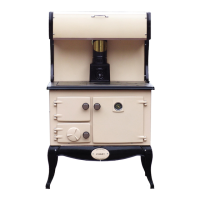DRAINING
Key - operated drain taps to B.S. 2879 should be
provided in accessible positions in all low parts of
the system. However it should be noted that there
may be short sections of pipework e.g. when pass-
ing under doorways that may be possible to drain.
GENERAL MAINTENANCE
It is important that the user is familiar with their heat-
ing system and that they ensure regular checks and
maintenance which can limit unnecessary break-
downs.
We recommend that you evaluate the overall insula-
tion in your house, i.e. attic, external walls, windows,
external doors. Insulation and draught proofing can
greatly reduce running costs, while equally enhanc-
ing living conditions.
FUELS
The Cooker output levels are assessed on standard
House Coal of good quality. Reduced outputs will
result when fuels of low calorific values are used.
Wood logs up to 21cm long are suitable.
All fuel should be stored under cover and kept as dry
as possible prior to use.
FUEL CALORIFIC VALUES
Anthracite 25-50mm C.V.: 8.2 kW/Kg = 14,000 Btu’s/lb
House Coal 25-75mm C.V.: 7.2 kW/Kg = 12,300 Btu’s/lb
Timber - Firebox Size C.V.: 5.0 kW/Kg = 8,600 Btu’s/lb
Peat Briquettes C.V.: 4.8 kW/Kg = 8,300 Btu’s/lb
Bog Peat C.V.: 3.4 kW/Kg = 6,000 Btu’s/lb
9
required minimum, a three-way mixing valve may be
fitted to the flow pipe to divert some hot water
straight back into the return. Such a valve can be
operated either manually or electrically in conjunc-
tion with a return pipe thermostat.
CARE FOR YOUR CENTRAL HEATING SYSTEM
We strongly recommend the use of suitable corro-
sion inhibitors and anti-freeze solution in your heat-
ing system, in an effort to minimise black oxide,
sludge and scale build-up, which effects efficiency.
In hard water areas the use of a suitable limescale
preventer / remover is advised.
Use only quantities specified by the water treatment
product manufacturer. Only add to the heating sys-
tem after flushing and finally refilling. Refer to BS
7953.
INJECTOR TEE (Central Heating)
Where the gravity and central heating circuits join
together to return to the Cooker we recommend the
use of an injector tee connection, situated as close
to the unit as possible. This type of tee encourages
a stable flow of hot water through both circuits and
helps to prevent priority being given to the stronger
flow, which is most commonly the pumped central
heating circuit. This way, there will be no shortage
of hot water to the taps when the heating is on.
Fig.12
Fig.13
LIGHTING THE FIRE
To access the firebox, after opening the firedoor
(Part No. 75) lift up and then tilt forward the firefence
(Part No 96). Lay a few crumpled sheets of paper
on the riddling grate (Part no. 44) then a few small
dry pieces of sticks or kindling. Open the spin valve
(Part no. 79) fully by rotating it in an anti-clockwise
direction. Turn the direct damper (Part no. 15) to
open by using the operating tool (Part No. 69). Now
light the paper, lift up the fire fence and close the fire
door (Part no. 75). When the kindling has caught
fire (allow 15 minutes for this to happen), add larger
pieces of dry wood, until the fire box is half filled.
When the larger pieces of wood have caught fire,
add fuel load.
Note: It is also possible to access the firebox by lift-
ing the hotplate (Part No 7) (See Hotplate Section).

